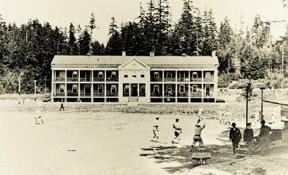When the Parade Grounds Park at Fort Ward is dedicated on Aug. 10, the ceremony won’t just be about a place preserved from development.
It will also be a group of people who had a significant role in preserving the nation’s freedom – the men and women who worked at the Naval Radio School during World War II.
“This is really the first opportunity we all have to say thanks to this group of guys for what they did,” said Sarah Lee, owner of the Fort Ward home that was the site of one of World War II’s most secretive projects.
The secret – what Lee calls “one of the biggest secrets during the the war” – is that the United States had cracked the Japanese code even before Pearl Harbor.
And while many of those who served at Fort Ward during the war were simply learning to send and receive radio messages, a small group of men were holed up in what was called “Station S,” eavesdropping on Japanese radio transmissions.
It wasn’t a simple problem. The Japanese receptions in Morse Code had to be deciphered. Then, to hide from Japanese listeners the fact that the code had been cracked, the messages had to be recoded before being passed on.
“They were listening for hours to transmissions that make no sense, but any mistake they made could be critical,” said Lee, who is herself a hobby short-wave radio operator.
“But they got the process down to where information could go from a radioman’s ears to the desk of the Secretary of State in 15 minutes,” Lee said.
The Parade Grounds, once used for ceremonial occasions and recreation, was the geographic center of the fort, tying together Station S at the north end and the remainder of the facility to the south. And it was also where the massive west-facing antennas were installed.
When the fort was decommissioned in the 1960s, some became the state park.
Much of the rest of the land, though, was purchased by developers who hurriedly carved it into tiny “recreational lots,” for sale to those looking for a weekend cabin site or even a place to pitch a tent.
And although the Parade Grounds was listed as a National Historic Site, it was still threatened with being turned into a housing development.
What saved the site was neighborhood activism. Two neighbors and the city donated plots of land to the park district to create a small park. Then the Kitsap County Consolidated Housing Authority got involved. It purchased the four acres of land, and developed a plan to put 20 homes around the perimeter, but retain the core as a park.
To commemorate the area’s past, veterans who served at Station S and who were at the Radio School will be guests of honor. The 25-piece Navy northwest regional band will play, a color guard will be in attendance, and one of the veterans will speak.
Veterans from across the country have indicated they will attend, said Lee, who is co-ordinating the activities in her capacity as a public-relations consultant to the KCCHA.
Community members like the confluence of past and present.
“This gives us a chance to celebrate that the Parade Grounds are happening and to tie that into the history of the place,” said Eileen Safford, president of the Fort Ward Neighborhood Association.
“This is the center of our community, and it will be neat for the neighbors, particularly the newer ones, to share the history of what happened here with the veterans.”



